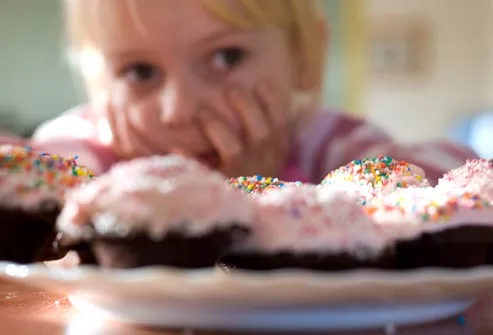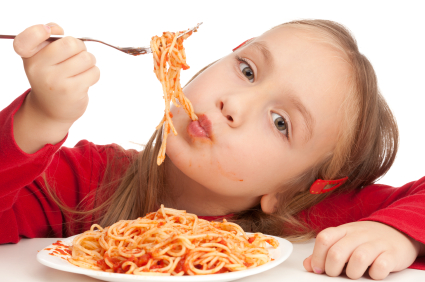
The British Broadcasting Company (BBC) released a documentary series called The Truth About Food. One of the episodes explains common misconceptions about children and food. The episode also gave helpful hints about helping your children to improve their eating habits. Here are the highlights from this documentary episode:
1. Don't forbid foods-- especially if they're in plain sight!

The worst thing you can tell a child is that they can't have that treat in the pantry. That food now becomes the "forbidden fruit," and their obsession with it will only grow. The documentary did an experiment with preschool aged children where they distributed two snacks of equal liking: dried mangoes and raisins. The children had rated the snacks equally before the experiment. The teachers told the children they could only have the mangoes until the last two minutes, at which point it was okay to have the raisins. However, they kept both snacks out in plain sight for the duration of snack time. They did this for a few days, and each day the children became more and more fixated on the raisins. It was observed that the children became territorial and even violent to get access to the raisins. By the end of the experiment, the children said that they liked raisins more than the mangoes, even though they had previously rated them equally.
Moral of the story: Don't tell your children that they're not allowed to eat a food, especially if it's in the house! It's as the old adage goes: everything in moderation.
2. There ARE ways to get your kids to eat that vegetable they hate.

The episode explored two main ways to get a picky young boy to eat broccoli – the first being peer pressure. Child actors, hired as classmates, were directed to speak to the boy about the glamorous life of acting and were also told convince him to eat his broccoli. The boy eventually gave in to peer pressure, tasting the broccoli and saying that he liked it after being encouraged by the child actors.
Because it's unrealistic to hire child actors for your kids, there is another option (though it requires more patience). Another young boy who didn’t like avocados was followed. His mother offered the avocado to him every day for ten days. After the ten days, he didn't love the avocados, but there was certainly an improvement in his preference. With more time, he might have even developed a preference for them.
Moral of the story: Peer pressure works, but if you can't manage that, then expose your children to the food over and over until there is a marked improvement (ten times is supposed to be the magic number).
3. Do Kids Stop When They're Full?

The documentary showed an experiment with young school children having lunch. On the first week, they prepared a daily lunch with a portion size of spaghetti and meat sauce that was deemed appropriate for their age by a registered dietitian. The children were given the portion and they happily ate the majority of their lunches. A week later, the children were given double the portion size of the same spaghetti and meat sauce. The results were astounding: the children had eaten 73% more with the bigger portion sizes. They even said yes to dessert after!
Moral of the story: monitor your children's portion sizes. They don't need adult sized plates at restaurants, and they don't need their food super-sized or king-sized.
4. Does Sugar Make Kids Hyper?

This is perhaps the most widespread notion: kids go crazy on sugar. In The Truth About Food, they decided to find out whether this is a myth. They had two birthday parties on two consecutive days. The first day, they showed the parents the food that would be served at the party and asked them to guess which foods their child would eat. They were told that for the first party, the kids would be eating healthy, sugar-free foods. In reality, the first party would be serving all the sugary treats that the kids could eat. The kids ate the sugar and then proceeded to participate in the underwater, story-telling themed party. The parents reported afterward how calm their children were.
The next day was the healthy lunch party, though the parents were told that their kids would be served sugary snacks. This party had more boisterous activities, like a bounce house. The children at this party were rowdy and energetic, and their parents commented afterward how hyper they were being, claiming it to be the effects of the sweets. Imagine their surprise when they learned that this was the sugar-free party!
Moral of the story: it's the activity, more than the food served, that affects how "boisterous" your child may be acting. However, too much sugar can lead to a drop in blood sugar afterward, which can cause irritability and moodiness. Make sure your children's sources of sugar mainly come in the form of fruit, milk products, and complex carbohydrates.
Sources:
http://www.bbc.co.uk/sn/humanbody/truthaboutfood/kids/takeaways.shtml
http://img.webmd.com/dtmcms/live/webmd/consumer_assets/site_images/articles/health_tools/feeding_a_picky_eater_slideshow/getty_rm_photo_of_child_looking_at_cupcakes.jpg
http://www.abc.net.au/radionational/image/4685852-3x2-700x467.jpg
http://static.squarespace.com/static/52c99a1ae4b05d3ee044c046/t/52f01a91e4b044da278d1b78/1391467154010/Child_Eating.jpg
http://renegadehealth.com/blog/wp-content/uploads/2013/02/Kids-Junk-Food.jpg
No comments:
Post a Comment